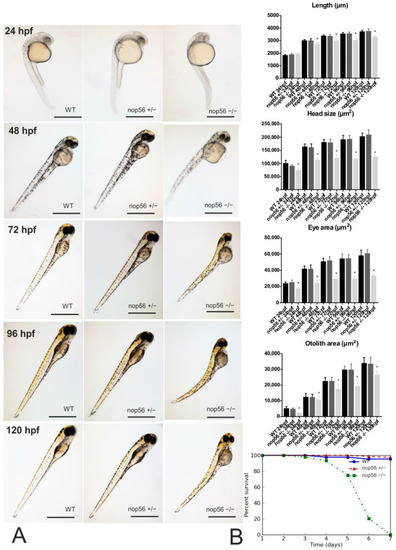Fig. 1
- ID
- ZDB-FIG-220829-211
- Publication
- Quelle-Regaldie et al., 2022 - A nop56 Zebrafish Loss-of-Function Model Exhibits a Severe Neurodegenerative Phenotype
- Other Figures
- All Figure Page
- Back to All Figure Page
|
(A): Phenotype of wild-type, nop56+/− and nop56−/− between 24 and 120 hpf. At 24 hpf, nop56−/− show statistically significant reduced head size, smaller eyes and smaller. At 48 hpf, statistically significant reduced body length can be also observed in nop56−/− embryos, as well as swollen yolk (in 100% of nop56−/− embryos) and curved body shape in (40% of the nop56−/− embryos). At 72 hpf, in addition to the previous features, there is cardiac edema in 77% of the embryos. In addition, at 96 and 120 hpf, there is total absence of swimming bladder in all nop56−/− embryos, curved body shape (in 50% of nop56−/− larvae) and a cardiac edema (in 88% of the nop56−/− larvae at 96 hpf and 100% at 120 hpf). For these parameters, no statistically significant differences were observed between wild type and nop56+/−. Statistically significant data in the graphs are indicated with a *. Scale bar: 1000 μm. (B) Kaplan–Meier survival graph for wild-type (n = 43), nop56+/− (n = 75) and nop56−/− (n = 44) zebrafish, revealing significantly different survivals for the nop56−/− embryos p < 0.0001. |
| Fish: | |
|---|---|
| Observed In: | |
| Stage Range: | Prim-5 to Days 7-13 |

